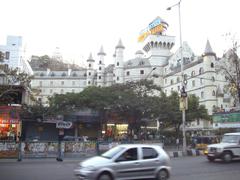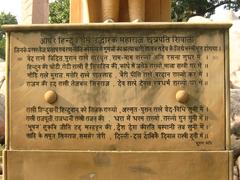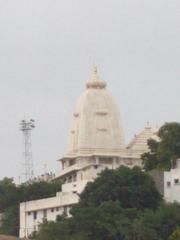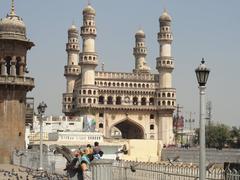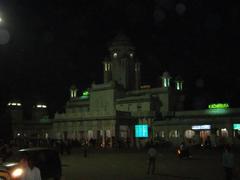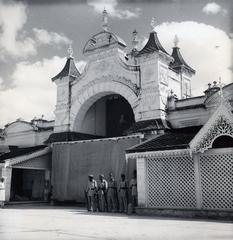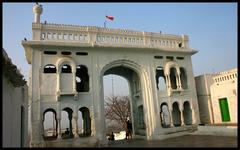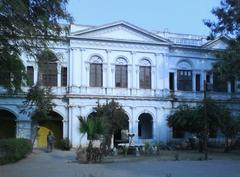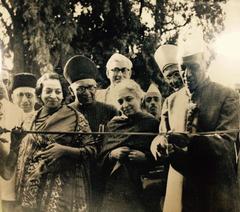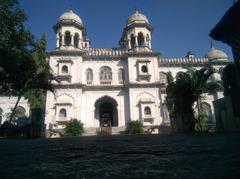
Birla Mandir Secunderabad Visitor Guide
Date: 17/07/2024
Introduction
Birla Mandir in Secunderabad, also known simply as the Birla Temple, stands as a monumental testament to India’s rich cultural and spiritual heritage. Dedicated to Lord Venkateswara, this Hindu temple is not only a marvel of modern Indian temple architecture but also a beacon of devotion, drawing thousands of visitors annually. Constructed by the Birla Foundation, a philanthropic arm of the illustrious Birla family, the temple’s construction spanned a decade from 1966 to 1976. The temple is renowned for its stunning blend of Dravidian, Rajasthani, and Utkala architectural styles, all meticulously crafted from white marble sourced from Rajasthan (Birla Mandir Official Website).
Perched atop the Naubath Pahad hillock, the temple offers panoramic views of Hyderabad and Secunderabad, making it not just a place of worship but a visual treat for architecture enthusiasts. The temple complex is a hub of cultural activities and spiritual education, hosting various religious events and festivals, such as the grand annual Brahmotsavam. It also serves as a center for Vedic learning, further cementing its role in the spiritual and cultural revival of post-independence India (Discover the Architectural Marvel of Birla Mandir in Secunderabad).
This comprehensive guide aims to provide you with detailed information on the temple’s history, architectural significance, visitor information, and much more. Whether you are a devotee seeking spiritual solace or a tourist exploring India’s cultural heritage, Birla Mandir in Secunderabad promises a memorable and enriching experience.
Table of Contents
- Introduction
- History of Birla Mandir, Secunderabad
- Architectural Significance
- Cultural and Religious Importance
- Modern-Day Relevance
- Visitor Information
- Frequently Asked Questions (FAQ)
- Conclusion
History of Birla Mandir, Secunderabad
Origins and Construction
Birla Mandir in Secunderabad, constructed by the Birla Foundation, a philanthropic organization established by the influential Birla family, took a decade to build. Construction began in 1966 and was completed in 1976. The temple is built entirely of white marble sourced from Rajasthan, and its architecture is a blend of Dravidian, Rajasthani, and Utkala styles.
Architectural Significance
Design and Construction
The architectural design of Birla Mandir is a testament to intricate craftsmanship. The temple stands on a 280-foot-high hillock called Naubath Pahad, offering a panoramic view of the twin cities of Hyderabad and Secunderabad. The main sanctum houses an 11-foot-tall idol of Lord Venkateswara, carved from black granite. The temple complex also includes shrines dedicated to other deities such as Padmavati, Andal, and various forms of Lord Vishnu.
Structural Elements
Gopuram and Vimana
The temple features a towering gopuram (gateway tower) at the entrance, characteristic of South Indian temple architecture. The gopuram is intricately carved with figures of deities, mythological scenes, and floral patterns. The Rajagopuram, or the main tower, is 42 feet high and is a marvel of architectural brilliance. The vimana (tower above the sanctum) is another significant architectural element, designed in the Dravidian style. The vimana is adorned with sculptures and carvings that depict various episodes from Hindu mythology.
Mandapam
The mandapam (pillared hall) is another architectural highlight of Birla Mandir. The hall is supported by intricately carved pillars, each depicting scenes from Hindu epics like the Ramayana and Mahabharata. The ceiling of the mandapam is equally impressive, featuring detailed carvings and frescoes that add to the temple’s grandeur.
Sculptural Art
The temple is renowned for its exquisite sculptural work. The marble sculptures are crafted with meticulous attention to detail, showcasing the skills of the artisans involved in the temple’s construction. The main deity, Lord Venkateswara, is enshrined in the sanctum sanctorum, and the idol is a magnificent piece of art, carved out of a single block of marble.
The temple also houses idols of other deities such as Lord Shiva, Goddess Saraswati, and Lord Ganesha, each sculpted with intricate details. The walls of the temple are adorned with bas-reliefs and sculptures that narrate various mythological stories, making the temple a repository of Hindu art and culture.
Symbolism and Iconography
The architectural design of Birla Mandir is rich in symbolism. The temple’s layout follows the principles of Vastu Shastra, the ancient Indian science of architecture, which ensures harmony and positive energy flow within the temple complex. The gopuram symbolizes the transition from the earthly realm to the divine, while the vimana represents the abode of the deity.
The carvings and sculptures are not merely decorative but also serve as a medium to convey spiritual and moral lessons. For instance, the depiction of various avatars of Lord Vishnu on the temple walls serves to educate devotees about the different manifestations of the deity and their significance.
Integration with Natural Surroundings
One of the unique aspects of Birla Mandir’s architecture is its seamless integration with the natural surroundings. The temple is built on a hillock, and the design takes advantage of the natural terrain. The steps leading up to the temple are carved out of the hill, and the landscaping around the temple includes lush gardens and water features that enhance the overall aesthetic appeal.
The elevated location of the temple not only provides a serene and tranquil environment for worship but also offers breathtaking views of the cityscape, especially during sunrise and sunset. This strategic placement adds to the spiritual ambiance of the temple, making it a perfect place for meditation and reflection.
Modern Architectural Techniques
While Birla Mandir adheres to traditional architectural styles, it also incorporates modern construction techniques. The use of reinforced concrete for the foundation and structural framework ensures the temple’s stability and longevity. The marble cladding is meticulously done to create a seamless and polished finish, showcasing the blend of traditional craftsmanship and modern engineering.
The temple is also equipped with modern amenities for the convenience of visitors, including well-maintained pathways, lighting, and seating areas. These facilities ensure that the temple can accommodate a large number of visitors without compromising on their comfort and safety.
Cultural and Religious Importance
Spiritual Significance
Birla Mandir is a cultural hub, hosting various religious and cultural events throughout the year, attracting devotees and tourists alike. One of the most significant events is the annual Brahmotsavam, a grand festival celebrated with much fervor and devotion. The temple also serves as a center for Vedic learning and spiritual education, with regular discourses and lectures on Hindu scriptures and philosophy.
Festivals and Rituals
Birla Mandir is a hub of religious activities and festivals, celebrated with great fervor and enthusiasm. One of the most significant festivals celebrated here is Vaikunta Ekadasi, which marks the opening of the Vaikunta Dwaram (the gate to heaven) and is believed to be an auspicious day for seeking the blessings of Lord Venkateswara. The temple also celebrates other major Hindu festivals like Diwali, Dussehra, and Janmashtami, each bringing its unique set of rituals and cultural performances. These festivals attract large crowds and offer a glimpse into the rich tapestry of Hindu traditions and customs.
Cultural Programs and Activities
In addition to religious activities, Birla Mandir hosts various cultural programs and activities that promote Indian art and culture. Classical music and dance performances, spiritual discourses, and cultural exhibitions are regularly organized within the temple premises. These events provide a platform for artists to showcase their talents and for visitors to experience the diverse cultural heritage of India. The temple’s cultural programs are particularly popular during festival times, adding to the overall festive atmosphere.
Educational and Social Initiatives
Birla Mandir is also involved in various educational and social initiatives aimed at the betterment of society. The temple runs a Vedic school where students are taught ancient scriptures, rituals, and the Sanskrit language. This initiative helps in preserving and propagating the ancient knowledge and traditions of Hinduism. Additionally, the temple engages in various charitable activities, including providing free meals to the needy, organizing health camps, and supporting educational programs for underprivileged children. These initiatives reflect the temple’s commitment to social welfare and community service.
Modern-Day Relevance
Pilgrimage and Tourism
Birla Mandir is a significant pilgrimage site for Hindus and a popular tourist attraction in Secunderabad. The temple’s serene ambiance, coupled with its stunning architecture and spiritual significance, makes it a must-visit destination for both devotees and tourists. The panoramic view of the city from the temple premises adds to its allure, offering visitors a chance to experience the tranquility and beauty of the surroundings. The temple’s strategic location, easily accessible from various parts of the city, further enhances its appeal as a tourist destination.
Inclusivity and Harmony
One of the most remarkable aspects of Birla Mandir is its inclusivity and promotion of religious harmony. The temple is open to people of all faiths, and its serene environment provides a space for individuals to connect with their spirituality, irrespective of their religious beliefs. This inclusivity is a reflection of the broader Indian ethos of unity in diversity, where different cultures and religions coexist harmoniously. The temple’s emphasis on promoting peace, love, and understanding among people of different backgrounds makes it a symbol of communal harmony and social cohesion.
Preservation and Maintenance
Maintaining a structure as grand as Birla Mandir requires meticulous care. The temple management undertakes regular maintenance and preservation activities to ensure the temple remains in pristine condition. Recent efforts have been made to make the temple more eco-friendly, including rainwater harvesting, solar energy utilization, and waste management.
Visitor Information
Visiting Hours and Tickets
Birla Mandir is open from 7 AM to 12 PM and from 3 PM to 9 PM daily. There is no entry fee, making it accessible to all visitors. However, donations are welcome.
Travel Tips
- Best Time to Visit: Early morning or late evening when the temple is less crowded and the natural lighting enhances the beauty of the marble structure.
- Dress Code: Modest clothing is recommended, and visitors are required to remove their footwear before entering the temple premises.
- Photography: Photography is generally not allowed inside the temple to preserve the sanctity of the place.
- Guided Tours: While there are no official guided tours, local guides are often available for hire to provide more insights into the temple’s history and architecture.
Nearby Attractions
- Hussain Sagar Lake: A beautiful lake offering boating facilities and scenic views.
- Lumbini Park: A well-maintained park ideal for family outings and relaxation.
- Salar Jung Museum: A museum with an extensive collection of art and artifacts.
Accessibility
The temple is accessible by road, and there are ample parking facilities available. Public transport options like buses and auto-rickshaws are also readily available. The temple is wheelchair accessible, ensuring that devotees with mobility challenges can visit comfortably.
Frequently Asked Questions (FAQ)
Q: What are the visiting hours for Birla Mandir, Secunderabad?
A: The temple is open from 7 AM to 12 PM and from 3 PM to 9 PM. It is advisable to check the official website for any changes in timings.
Q: Is there an entry fee or ticket required to visit Birla Mandir?
A: No, there is no entry fee to visit Birla Mandir.
Q: Are there guided tours available at Birla Mandir?
A: Guided tours are not officially provided, but you can find detailed information and virtual tours on the temple’s official website.
Q: What are some nearby attractions to visit?
A: Nearby attractions include Hussain Sagar Lake, Lumbini Park, and the Salar Jung Museum.
Q: Is Birla Mandir accessible to differently-abled visitors?
A: The temple management has made efforts to ensure accessibility, but it is advisable to check specific facilities on the official website.
Conclusion
Birla Mandir in Secunderabad is more than just a place of worship; it is a cultural and spiritual hub that embodies the rich heritage and traditions of India. Its history, architectural beauty, and cultural significance make it a landmark that continues to inspire and attract people from all walks of life. Whether you are drawn by its architectural splendor, cultural significance, or spiritual ambiance, a visit to Birla Mandir promises an enriching and unforgettable experience. The temple’s inclusive approach and various social initiatives reflect a broader ethos of unity and harmony, making it a symbol of communal harmony and social cohesion. For more information, visit the Birla Mandir Official Website.
Call to Action
Stay updated with the latest events and information by following us on social media and downloading our mobile app Audiala for a more interactive experience.
References
- Visiting Birla Mandir, Secunderabad - History, Architecture, and Visitor Information, 2024, Birla Mandir Official Website https://www.birlamandir.org
- Discover the Architectural Marvel of Birla Mandir in Secunderabad - Visiting Hours, Tickets, and More, 2024, Birla Mandir Official Website https://www.birlamandir.org
- Visiting Birla Mandir in Secunderabad - Hours, Tickets, and Cultural Significance, 2024, Birla Mandir Official Website https://www.birlamandir.org
